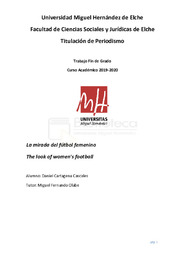Por favor, use este identificador para citar o enlazar este ítem:
https://hdl.handle.net/11000/27087Registro completo de metadatos
| Campo DC | Valor | Lengua/Idioma |
|---|---|---|
| dc.contributor.advisor | Olabe Sánchez, Miguel Fernando | - |
| dc.contributor.author | Cartagena Cascales, Daniel | - |
| dc.contributor.other | Departamentos de la UMH::Ciencias Sociales y Humanas | es_ES |
| dc.date.accessioned | 2022-05-13T11:12:01Z | - |
| dc.date.available | 2022-05-13T11:12:01Z | - |
| dc.date.created | 2020-06-13 | - |
| dc.identifier.uri | http://hdl.handle.net/11000/27087 | - |
| dc.description.abstract | En este análisis del fútbol femenino centramos la atención en el punto de vista de dos agentes cruciales para que este deporte siga creciendo en España de la manera que lo está haciendo, para ello contamos con periodistas especializados, que nos darán una visión de cómo ven ellos este deporte, profundizando en lo que se está haciendo mal a día de hoy, pero sin dejar de lado la responsabilidad que éstos tienen en muchas de las cosas que hay por mejorar. Un tema muy importante que se aborda es la poca visibilidad que este deporte tiene con respecto a otros países como: Francia y Estados Unidos, donde el seguimiento del fútbol femenino es mayor que en nuestro país. En este sentido, cabe destacar el partido de la final de la Copa de la Reina 2019, que congregó a más de 2 millones de espectadores, convirtiéndose así en el mayor evento de fútbol femenino en España. Demostrando así, que a los espectadores les interesa este deporte y que los medios deberían apostar más por él. | es_ES |
| dc.description.abstract | In this análisis of women’s football we focus attention on the point of view of two agents crucial for this sport to continue to grow in Spain in the way it is doing, for this we have specialized journalists, that will give us a vision of how they see this sport, delving into what is being done wrong today, but without neglecting the responsibility they have in many of the things that need to be improved. A very important issue that is addressed is the low visibility that this sport has with respect to other countries such as: France and the United States, where the following of women’s football is greater than in our country. In this sense, it is worth noting the match of the final of La Copa de la Reina 2019, which gathered more than 2 million spectators, becoming the largest women’s football event in Spain. Thus demonstrating that spectators are interested in this sport and that the media should do more for it. | es_ES |
| dc.format | application/pdf | es_ES |
| dc.format.extent | 19 | es_ES |
| dc.language.iso | spa | es_ES |
| dc.publisher | Universidad Miguel Hernández de Elche | es_ES |
| dc.rights | info:eu-repo/semantics/openAccess | es_ES |
| dc.rights | Attribution-NonCommercial-NoDerivatives 4.0 Internacional | * |
| dc.rights.uri | http://creativecommons.org/licenses/by-nc-nd/4.0/ | * |
| dc.subject | fútbol femenino | es_ES |
| dc.subject | visibilidad | es_ES |
| dc.subject | medios | es_ES |
| dc.subject | España | es_ES |
| dc.subject | audiencia | es_ES |
| dc.subject | female football | es_ES |
| dc.subject | visibility | es_ES |
| dc.subject | media | es_ES |
| dc.subject | Spain | es_ES |
| dc.subject | audience | es_ES |
| dc.subject.other | CDU::0 - Generalidades.::070 - Periódicos. Prensa. Periodismo. Ciencias de la información | es_ES |
| dc.title | La mirada del fútbol femenino | es_ES |
| dc.title.alternative | The look of women's football | es_ES |
| dc.type | info:eu-repo/semantics/bachelorThesis | es_ES |

Ver/Abrir:
TFG-Cartagena Cascales, Daniel.pdf
821,61 kB
Adobe PDF
Compartir:
 La licencia se describe como: Atribución-NonComercial-NoDerivada 4.0 Internacional.
La licencia se describe como: Atribución-NonComercial-NoDerivada 4.0 Internacional.
.png)